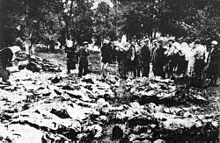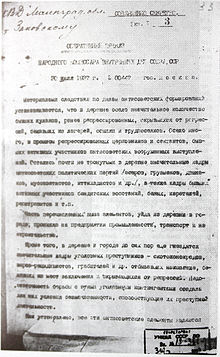
Back Groot Suiwering Afrikaans Großer Terror (Sowjetunion) ALS التطهير الكبير Arabic Gran Purga AST Böyük təmizləmə Azerbaijani بؤیوک تمیزلهمه AZB Оло террор Bashkir Голяма чистка Bulgarian Spurjadennoù Bras Breton Gran Purga Catalan
This article may require copy editing for grammar, style, cohesion, tone, or spelling. (November 2023) |
| Great Purge | |
|---|---|
| Part of the purges of the Communist Party of the Soviet Union | |
 People of Vinnytsia searching through the exhumed victims of the Vinnytsia massacre, 1943 | |
| Location | Soviet Union, East Turkestan, Mongolian People's Republic |
| Date | 1936–1938 |
| Target | Political opponents, Trotskyists, Red Army leadership, kulaks, religious activists and leaders |
Attack type | |
| Deaths | 681,692 executions and 116,000 deaths in the Gulag system (official figures)[1]
700,000 to 1.2 million (estimated)[1] [2][3] |
| Perpetrators | Joseph Stalin, the NKVD (Genrikh Yagoda, Nikolai Yezhov, Lavrentiy Beria, Ivan Serov and others), Vyacheslav Molotov, Andrey Vyshinsky, Lazar Kaganovich, Kliment Voroshilov, Robert Eikhe and others |
| Motive | Elimination of political opponents,[4] consolidation of power,[5] fear of counterrevolution,[6] fear of party infiltration[7] |
| Mass repression in the Soviet Union |
|---|
| Economic repression |
| Political repression |
| Ideological repression |
| Ethnic repression |
| Part of a series on the |
| History of the Soviet Union |
|---|
 |
|
|
The Great Purge, or the Great Terror (Russian: Большой террор, romanized: Bolshoy terror), also known as the Year of '37 (37-й год, Tridtsat sedmoy god) and the Yezhovshchina (Ежовщина, 'period of Yezhov'),[8] was Soviet General Secretary Joseph Stalin's campaign to consolidate power over the Communist Party of the Soviet Union and Soviet state. The purges also sought to remove the remaining influence of Leon Trotsky. The term great purge was popularized by the historian Robert Conquest in his 1968 book The Great Terror, whose title was an allusion to the French Revolution's Reign of Terror.[9]
The purges were largely conducted by the NKVD (People's Commissariat for Internal Affairs), which functioned as the interior ministry and secret police of the USSR. Starting in 1936, the NKVD under chief Genrikh Yagoda began the removal of the central party leadership, Old Bolsheviks, government officials, and regional party bosses.[10] Soviet politicians who opposed or criticized Stalin were removed from office and imprisoned or executed by the NKVD. Eventually, the purges were expanded to the Red Army and military high command, which had a disastrous effect on the military.[11][12] The campaigns also affected many other categories of the society: intelligentsia, peasants—especially those lending out money or wealth (kulaks)—and professionals.[13] As the scope of the purge widened, the omnipresent suspicion of saboteurs and counter-revolutionaries began impacting civilian life. The purge reached its peak between September 1936 and August 1938 under the leadership of Nikolai Yezhov, hence the name Yezhovshchina. The campaigns were carried out according to the general line of the party, often by direct orders of the politburo headed by Stalin.[14] Hundreds of thousands of victims were accused of various political crimes (espionage, wrecking, sabotage, anti-Soviet agitation, conspiracies to prepare uprisings and coups). They were executed by shooting or sent to the Gulag labor camps. Many died at the penal labor camps of starvation, disease, exposure, and overwork. The NKVD targeted certain ethnic minorities such as the Volga Germans, and Soviet citizens of Polish origin, who were subjected to forced deportation and extreme repression. Throughout the purge, the NKVD sought to strengthen control over civilians through fear, and frequently used imprisonment, torture, violent interrogation, and executions during its mass operations.[15]
In 1938, Stalin reversed his stance on the purges, criticized the NKVD for carrying out mass executions, and oversaw the execution of Genrikh Yagoda and Nikolai Yezhov, who headed the NKVD during the purge years. Scholars estimate the death toll for the Great Purge (1936–1938) to be roughly 700,000-1.2 million.[16][17][18][19][20] Despite the end of the Great Purge, the widespread surveillance and atmosphere of mistrust continued for decades. Similar purges took place in Mongolia and Xinjiang. While the Soviet government desired to put Trotsky on trial during the purge, his exile prevented this. Trotsky survived the purge, though he would be assassinated in 1940 by the NKVD on the orders of Stalin.[21][22]

- ^ a b Cite error: The named reference
EllmanCommentwas invoked but never defined (see the help page). - ^ Cite error: The named reference
Kuhrwas invoked but never defined (see the help page). - ^ Cite error: The named reference
Xavierwas invoked but never defined (see the help page). - ^ Conquest 2008, p. 53.
- ^ Brett Homkes (2004). "Certainty, Probability, and Stalin's Great Party Purge". McNair Scholars Journal. 8 (1): 13.
- ^ Harris 2017, p. 16.
- ^ James Harris, "Encircled by Enemies: Stalin's Perceptions of the Capitalist World, 1918–1941," Journal of Strategic Studies 30#3 [2007]: 513–45.
- ^ In Russian historiography, the period of the most intense purge, 1937–1938, is called Yezhovshchina (lit. 'Yezhov phenomenon'), after Nikolai Yezhov, the head of the NKVD.
- ^ Helen Rappaport (1999). Joseph Stalin: A Biographical Companion. ABC-CLIO. p. 110. ISBN 978-1576070840. Retrieved 29 September 2015.
- ^ "Tokaev Comrade X 1956" – via Internet Archive.
- ^ Whitewood, Peter (13 June 2016). "Rethinking Stalin's Purge of the Red Army, 1937–38". University Press of Kansas Blog. Retrieved 3 December 2021.
- ^ Uldricks, Teddy J. (1977). "The Impact of the Great Purges on the People's Commissariat of Foreign Affairs" (PDF). Slavic Review. 36 (2): 187–204. doi:10.2307/2495035. JSTOR 2495035. S2CID 163664533.
- ^ Conquest 2008, pp. 250, 257–58.
- ^ Goldman, W. (2005). "Stalinist Terror and Democracy: The 1937 Union Campaign". The American Historical Review, 110(5), 1427–53
- ^ Figes 2007, pp. 227–315.
- ^ "Introduction: the Great Purges as history", Origins of the Great Purges, Cambridge University Press, pp. 1–9, 1985, doi:10.1017/cbo9780511572616.002, ISBN 978-0521259217, retrieved 2 December 2021
- ^ Homkes, Brett (2004). "Certainty, Probability, and Stalin's Great Purge". McNair Scholars Journal.
- ^ Ellman, Michael (2002). "Soviet Repression Statistics: Some Comments". Europe-Asia Studies. 54 (7): 1151–1172. ISSN 0966-8136.
- ^ Shearer, David R. (11 September 2023). Stalin and War, 1918-1953: Patterns of Repression, Mobilization, and External Threat. Taylor & Francis. p. vii. ISBN 978-1-000-95544-6.
- ^ Nelson, Todd H. (16 October 2019). Bringing Stalin Back In: Memory Politics and the Creation of a Useable Past in Putin’s Russia. Rowman & Littlefield. p. 7. ISBN 978-1-4985-9153-9.
- ^ "Leon Trotsky – Exile and assassination | Britannica". www.britannica.com. Retrieved 27 April 2022.
- ^ Schatman, Max (1938). Behind the Moscow Trials.
© MMXXIII Rich X Search. We shall prevail. All rights reserved. Rich X Search